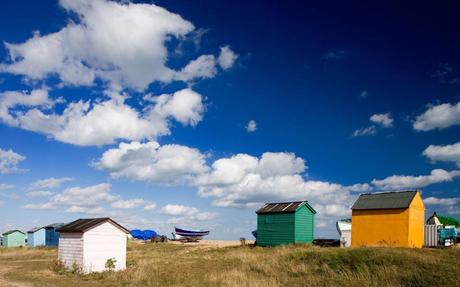
The first time I went to Littlestone-On-Sea I parked the car, got out and got straight back in. I'd driven the 10 minutes from Dungeness, where outsized skies stretched over pebbles full of alien plants and designer huts, and where the strange dry gardens felt like a glimpse of a possible future (one in which we might all practice horticulture on the moon).
With this incredible landscape in mind, Littlestone was the ultimate anti-climax. Gray waves crashed on steep stones and along the road behind them lay a jumble of dull flats and peeling houses.
This would have been a huge disappointment to Sir Robert Perks, the 19th century politician and property developer who hoped to transform the small village into a spa town in the 1880s. Progress was slow, perhaps hampered by the fact that his associate Henry Tubbs, the owner of the local golf club (and builder of the red-brick water tower that still stands proudly as the tallest thing on the horizon) was a staunch supporter of the temperance movement. .
When the gray skies open over Littlestone, thoughts inevitably turn to alcohol - but he made sure it was unavailable to visiting golfers. Despite this, Bright Young Things did eventually happen. In the interwar period they built a whole series of large holiday homes near Tubbs golf club. But cheap flights arrived shortly afterwards - and Littlestone once again faded into obscurity.
Beyond the village's striped beach huts, where the main road winds towards Hythe, there are still some of these houses. A handful, like the one I encountered at the seaside, happily belting out Frank Sinatra songs from behind a rainbow cloak of laundry, appear to be slowly decaying. Others, situated around the grassy roads near the golf club, are now the definition of respectability, their facades freshly painted and Union Jacks flying from their flagpoles.
And now there are signs that Littlestone will soon have another moment in the sun. Since my last visit, old mansions with cedar cladding and floor-to-ceiling windows have sprung up among the old mansions. Meanwhile, Harry Cragoe, the hotelier behind the highly successful Gallivant hotel in Camber Sands (doubles from £165, B&B), will open an outpost in Littlestone in 2024.
The story continues
He has picked a winner with the building. The hotel was originally designed as a holiday home for a woman called Margaret Bray by the architect behind Portmeirion, Sir Clough Williams-Ellis. "She moved in some very interesting circles. She was a real avant-garde lady," says Cragoe. Legend has it that Noel Coward and members of the Astor family remained, although actual evidence is scarce.
The facade is set at a 45 degree angle to the sea, as if to stand out from the other buildings on the boulevard, and has a distinctly Gatsby-esque look, albeit a little faded. But while the revelers in that novel partied hard on Long Island, the most those in Littlestone can currently hope for are a takeaway curry or fish and chips on the concrete seawall. Even coffee seems impossible to find (unless you count the takeaway Costa machine at the local Spar).
The challenge for Cragoe will be to ensure that visitors in the upstairs bedrooms, from where views stretch to France on clear days, won't wish they had traveled the extra few miles and crossed the Channel. With this in mind there's a Bamford spa, a wood-fired sauna for post-swim warm-ups, a dry garden on a grander scale than Dungeness and a wine list full of English treasures. "Our plan with Littlestone is to bring back the glamour. It was clearly once a very trendy holiday destination, especially for Londoners," he says.
The golf course, once Littlestone's biggest selling point, is also still a draw. "If you're a golfer, Alister MacKenzie is the Nash of golf designers. He designed Cypress Point and the Augusta course where the Masters is played," Cragoe said. "He came over after the war to redevelop the club in Littlestone because the whole area was being used by the army for training and the golf course was being dug up. It means there is a deep connection to the very best golf courses in America. That heritage may be somewhat overshadowed by the Rye Golf Course, but Littlestone also has an amazing history."
If anyone can change Littlestone's fate, it is Cragoe. His other hotel has added much to the appeal of Camber Sands. "My friends definitely thought so [deluded] buy that place. It was a run-down roadside motel that was busy with families for two months and empty the rest of the time."
"Through a lot of hard work, a lot of money and a real vision of what we wanted to do, we created something very special. Littlestone is the logical next step for us. As a blank canvas it is much more exciting because [...] you have a very beautiful structure in the most remarkable location."
His timing is good too. Along the coastal path, a handful of cyclists with cut-glass accents ring their bells for pedestrians to get out of the way in a manner reminiscent of London's pedal boats, signaling that weekenders are already in town. And if you walk 10 minutes from Cragoe's building towards St Mary's Bay, you'll reach Cabu by the Sea, a collection of chic cabins popular with celebrity couples and families. As the tide ebbs, there's another surprise: ripples of sand beyond the pebbles to entice those sniffing at gravel.
As for me, the sun shone on my second visit to Littlestone, turning the water into sequins and throwing the distant colossus of the Dungeness Power Station into hazy relief. The empty beach could never be called beautiful, but under the intense blue of a cloudless sky it was refreshingly dramatic. I walked back to the beach car park, stopping at Spar on the way to pick up a latte. Then I sat on the boulevard and toasted to a better future.
